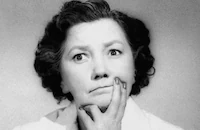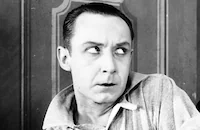Hit Parade of 1941
Brief Synopsis
Cast & Crew
John H. Auer
Kenny Baker
Frances Langford
Hugh Herbert
Mary Boland
Ann Miller
Film Details
Technical Specs

Synopsis
Small radio station WPX is being forced out of business by bigger stations, and so manager Phil Harrison must renew the contract of the Farraday Trading Post, an antique and junk shop that is one of their most important accounts. Unfortunately, David Farraday, the nephew of Ferdinand, the eccentric owner of the trading post, persuades his uncle to cancel their account for economic reasons. Harrison takes general manager Charles Moore and two of his singers, the lovely Pat Abbott and her sister Judy, to the trading post, where the women distract David while Harrison convinces Ferdinand to trade his shop for ownership of the radio station. David is furious about the subterfuge and fires Pat and Judy for their part in it. Later, Ferdinand and David are settling into the big city when Charlie brings them the upsetting news that the big stations are installing commercial television equipment, and that WPX will have to do likewise if they are to remain competitive. David feels cheated once again, for he realizes that Harrison must have seen the upheaval coming and that is why he unloaded the station on Ferdinand. Things become even more complicated when Ferdinand unthinkingly buys television equipment with a ninety-day bank loan that uses the trading post as collateral, even though he no longer owns it. The new television station must make money quickly to save the Farradays from possible legal entanglements, and they begin broadcasting a live "trading post of the air" swap meet. When the show begins to affect the business of Emily Potter's department store, she agrees with the suggestion of her manager, Mr. Carter, to sponser the show. Because WPX desperately needs her money, David agrees to her terms, which are that her daughter Annabelle, who is a great dancer but a bad singer, sing on the show. David comes up with a scheme to keep the Potter money and their newfound audience by having Pat, with whom he is falling in love, sing from a hidden part of the stage while Annabelle performs and sings into a dead microphone. The show and Annabelle are a smash, but Pat grows bitter as David spends more time with his new star, while she is hidden further from the limelight. Annabelle mistakes David's attentions and, not realizing that he is just trying to keep her mother happy, announces their engagement. Judy pleads with Pat to break with David, but Pat refuses to renege on her commitment to the show. One night, though, Judy reveals the singing ruse during a show by turning on Annabelle's microphone and switching between it and Pat's. It appears that WPX is ruined, but the show has increased business so much for the department store that Emily hires Pat as the singer for a new show. David accuses Pat of double-crossing him, but she reveals that her contract with Emily stipulates that the show must be broadcast from WPX. Ferdinand outwits Harrison when he attempts to buy back the station, and all ends happily as Annabelle, who much prefers to dance than sing, becomes a featured dancer on the show, and David and Pat, Charlie and Judy, and Emily and Ferdinand declare their love for each other.

Director
John H. Auer
Cast

Kenny Baker

Frances Langford

Hugh Herbert

Mary Boland

Ann Miller

Patsy Kelly

Phil Silvers

Sterling Holloway

Donald Macbride
Barnett Parker

Franklin Pangborn
Six Hits And A Miss
Borrah Minevitch And His Harmonica Rascals
Crew
Harry Akst
George Blair
Walter Bullock
Con Conrad
Danny Dare
Benny Davis
Cy Feuer
L. Wolfe Gilbert
Ray Golden
Clifford Grey
Will J. Harris
F. Hugh Herbert
Jerome Kern
Sid Kuller
Maurice Leo
Sam M. Lewis
Abe Lyman
John Victor Mackay
Jack Marta
William Morgan
Adele Palmer
J. Russel Robinson
Bradford Ropes
Gene Rose
Walter Scharf
Murray Seldeen
Sol C. Siegel
Jule Styne
George Waggner
Mabel Wayne
Al Wilson
Joe Young
Victor Young

Film Details
Technical Specs

Award Nominations
Best Score
Best Song
Quotes
Trivia
Notes
The credits and plot summary of this film were obtained from contemporary sources and the cutting continuity of Romance and Rhythm, a re-edited, re-issue of Hit Parade of 1941. Republic intended to make this picture as a follow-up to its 1937 film The Hit Parade, but production was delayed several times. The picture was originally intended as a starring vehicle for Phil Regan, the star of The Hit Parade, with Alison Skipworth, Polly Moran and Max Terhune as his co-stars and Colbert Clark acting as the film's producer. Regan's contract disputes with Republic were one of the reasons for the film's delay. A May 5, 1939 Hollywood Reporter news item reported that production was stalled because none of the desired big bands were available, while a June 1939 Hollywood Reporter news item noted that the picture had been taken off the production schedule in order to delete from the script "the WPA theme over which difficulties arose." On September 29, 1939, Hollywood Reporter reported that Republic president Herbert J. Yates had postponed production in the hope that "war conditions" would have settled by January 1, 1940, the proposed starting date of filming.
Among the writers assigned to work on the film at various times were: Bradford Ropes, Vera Caspary, Gordon Rigby, Rian James and Manny Seff. Their contribution to the completed film has not been confirmed, however. Songwriters scheduled to work on the film included Peter Tinturin and Jack Lawrence. According to Hollywood Reporter news item, in the fall of 1939, Ralph Murphy was slated to direct the picture, and Republic negotiated with Twentieth Century-Fox to borrow the Ritz Brothers, although the comedians refused to appear in the film. According to Hollywood Reporter and New York Times news items, Lionel Stander was originally set for the role of "Charles Moore," but was removed from the picture after he "was subpoenaed to testify before the Los Angeles County Grand Jury in what the District Attorney's office termed a 'fifth column expose.'" Stander was replaced by Phil Silvers, who was borrowed from M-G-M. The New York Times article noted: "Republic explained the replacement by saying they feared Stander might be called to testify further during production. The studio paid him $3,000 to break their commitment." No additional information about Stander's removal from the picture has been found.
Hollywood Reporter production charts include January Garber and his band in the cast, but their participation in the completed picture has not been confirmed. The film's production file at the AMPAS Library contains a Republic billing sheet on which dance director Danny Dare's name is crossed out and Hermes Pan's name is written in. No information confirming Pan's involvement with the film has been found. Contemporary sources note that the film's budget was between $350,000 and $500,000. According to the MPAA/PCA Collection at the AMPAS Library, Joseph I. Breen, the Director of the PCA, read the film's shooting script and commented on one scene to producer Sol C. Siegel: "It would be well for you to take counsel...it is very likely that your picture will encounter trouble in the Southern states if the colored and white entertainers are shown together on the same stage in this concluding number." Cy Feuer received an Academy Award nomination in the Music (Scoring) category, and Jule Styne and Walter Bullock's song "Who Am I?" was nominated in the Music (Song) category.

Miscellaneous Notes
Released in United States 1940
Released in United States 1940











